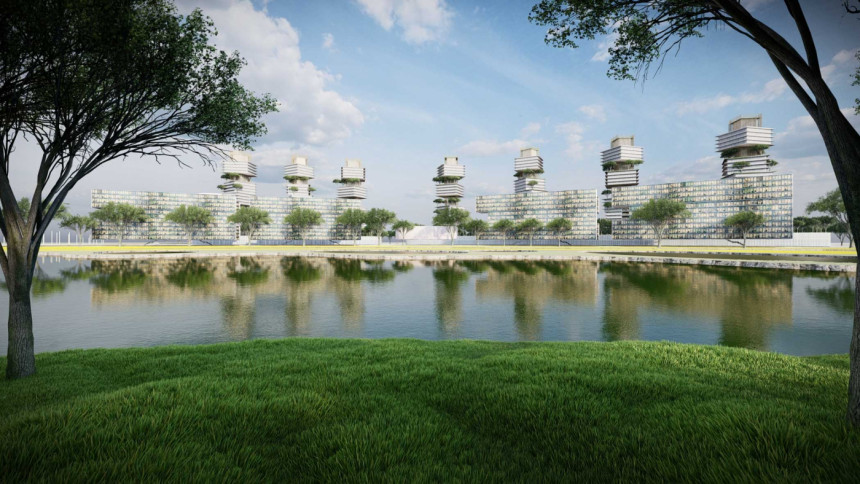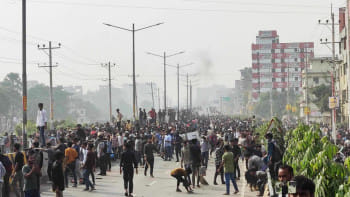Dhaka needs new urban-forms

If the city is the new challenge of the time, the "edge" of the city is at the heart of it.
It is clear now that most of the challenges of the future will be environmental. The proliferation and expansion of cities will be the most critical one. What will be the nature of future cities and towns? How will the expanding city impact the extra-urban landscape? How will villages transform? Will the future city and village merge into a third settlement type? It appears to me that all these questions are intersecting at the edge.
A few days ago, I was visiting Purbachal—the Dhaka of tomorrow. With new gridded road layouts, plotted out land waiting for habitation, but until then a vegetable garden, and the profusion of temporary installations of eateries, it already appears to be a brand-new landscape. The scale of operation is incredible. Over 24 sq kms of a terraqueous condition has been converted into that brand new landscape. Sanjoy Roy, geographer at Bengal Institute, calculates that the volume of earth-fill is 79 million cubic metres. Wetlands, which were 6.82 sq km in 2005, were reduced to 1.76 sq km in 2021. Forested lands and homesteads, which were 7 sq km in 2005, were brought down to 1.91 sq km in 2021. Roy estimates that the total landfill in Purbachal is equivalent to 32 Great Egyptian Pyramids of Giza!
That kind of astounding figure from Purbachal reminds us that the transformation of Dhaka and its watery regions, along with its physical and social landscape, has been relentless and brutal. But it also makes us think if we can create such a totally new landscape, and at such a monumental scale, why can't we make one that is unique, addresses development needs, and is attentive to the original terraqueous terrain?
In a place where water is the fundament, and hydrological planning a prerequisite for any development, a dry ideology is instead celebrated. Buildings are built by filling in wetlands. Rivers and canals are encroached upon in the name of industrialisation. Water bodies and channels are polluted indiscriminately. It appears that nature and development—prokriti and progoti—face each other in a tragic opposition. Additionally, the complexities related to climate change remains unaccounted for. In order to create a balance among progress, nature and climate change, an estuary of these three is necessary. A newer way of thinking about life and living that is commensurate with our landscape is required. Only then we will have developed a Bengali urbanism.
Life in Bangladesh is impossible without considering water and its flows. This has become more urgent in the time of climate change. Settlements and habitats here will have to include rivers, canals, wetlands and paddy fields in their formations. Considering the richness of the land and the dynamics of the hydro-geography, such formation is inevitable. In adapting to diverse changes, from the environmental to climate, and from the technological to migrational, Bangladesh can still arrive at novel and humane cities.
Most planners and architects trained in conventional methods remain bewildered by the geographic question, and are unable to conceive alternative city-forms. Architects are basically content in their allocated lots and plots to be ironic or spectacular. Creating an eye-catching apartment or commercial building is not enough to make a better and equitable city. When once architecture and the city formed a twinness, the parameters of one enhancing the other, there is now a contention. While architects make stunning architecture, the city goes to hell.
Few years ago, I wrote a piece in a Chinese architectural journal in which I summarised the condition of Dhaka in the following way:
"A hydro-geographical landscape calls for a different measure in design thinking and practice. Considering that an aqueous urbanism entails an epistemic shift, this article locates the city of Dhaka as a point of departure for such a thinking. What distinguishes Dhaka from other cities in similar growth outbursts is its deeply intertwined relationship with a landscape moulded by powerful rivers, epic floods, silting and land-shifting of monumental proportions. In that fluctuating hydrological world of the delta, cities and settlements have been structured by the dynamics of rivers, canals, wetlands, floodplains, agricultural fields, chars (silted landforms) and human habitation. Such a deltaic milieu calls attention for imagining an aqueous urbanism, and even a new water ethos in contemporary design discourse. Such a hydraulic vision for cities has to begin from the edge of the precious landscape of wetlands and agricultural terrain, urging for a conception that integrates urbanism, agriculture, and flood terrains."
It seems clear that the location for the urban turmoil is the "edge" of the known city, an edge that is constantly shifting. The biggest challenge in the re-composition of Dhaka lies in how to understand that edge, and from there how to develop a new city form, something better than Purbachal.
Most urban planners and policymakers in Dhaka focus on the core city. Even when they are dealing with the edge, they see it in the image of the core. Official planning is unable to conceptualise this edge as its own ecology. Without that realisation it is easy to participate in the destruction of the city's hydro-geographical wealth. An audacious vision for Dhaka has to begin from the edge in which the norm of privileging the core has to be reversed.
The famous Dutch architect and urbanist Rem Koolhaas claimed that the edge of the city is where the action is. He meant the frazzled fabric of the post-industrial Euro-American city, or its tattered suburbia. In Dhaka, the geography of the edge is determined by the built-city marching up to meet the "non-urban," a magnificent but precious terrain of land-water event made of wetlands, flood-plains, canals, and agricultural fields. The edge is where the dry meets the wet, the "developed" meets the "rustic," and infrastructure meets the structure-less. This is also where the urbanite meets the farmer, the land grabber discovers his opportunity, and the uprooted often makes her habitation. Site/s of the biggest battle in the city, the terrain of the edge is determined by the presence and flux of water. No planning scheme will work for Dhaka if this simple equation is not recognised.
Nothing short of imagining a new city-form will offer a salvation for Dhaka. The edge conditions of Dhaka present the possibility of re-negotiating the social and economic, as well as conceptual, separation between city and its conventional anti-thesis, whether the village or agricultural plains. The edge is where new forms of space organisation will have to be imagined, along with newer types of economic and social opportunities. Neither fully a village-form nor completely a core city-form, the new form can be a third settlement type. With dense habitats on a precise footprint, but enhancing the edge ecology, the new edge will also bring solutions to the crises at the core. It's a matter of imagination.
Kazi Khaleed Ashraf is an architect and urbanist, and directs the Bengal Institute for Architcture, Landscapes and Settlements. Part of the text appeared in "Designing Dhaka: A Manifesto for a Better City" (2012).


 For all latest news, follow The Daily Star's Google News channel.
For all latest news, follow The Daily Star's Google News channel. 



Comments